Foreword / YouTube Video Review
The review on this website is a brief overview and summary of the objective performance of this speaker. It is not intended to be a deep dive. Moreso, this is information for those who prefer “just the facts” and prefer to have the data without the filler. The video below has more discussion.
Information and Photos
The Kef R2c is 3-way compact Center Channel speaker. It features dual 5.25-inch midwoofers and a 5-inch concentric “Uni-Q” midrange/tweeter in a sealed cabinet. The crossover between the midbass/midrange is 400Hz and the crossover between the midrange/tweeter is 2.9kHz.
Price is approximately $1200 USD for this speaker.
CTA-2034 (SPINORAMA) and Accompanying Data
All data collected using Klippel’s Near-Field Scanner. The Near-Field-Scanner 3D (NFS) offers a fully automated acoustic measurement of direct sound radiated from the source under test. The radiated sound is determined in any desired distance and angle in the 3D space outside the scanning surface. Directivity, sound power, SPL response and many more key figures are obtained for any kind of loudspeaker and audio system in near field applications (e.g. studio monitors, mobile devices) as well as far field applications (e.g. professional audio systems). Utilizing a minimum of measurement points, a comprehensive data set is generated containing the loudspeaker’s high resolution, free field sound radiation in the near and far field. For a detailed explanation of how the NFS works and the science behind it, please watch the below discussion with designer Christian Bellmann:
The reference plane in this test is at the tweeter/midrange. The speaker was laid on its side (as it will typically be used). I did perform testing with the speaker in vertical orientation, included at the end of this review. Initial testing in this review was done without grille. However, at the end of this review I do have results from testing with the grille on.
Measurements are provided in a format in accordance with the Standard Method of Measurement for In-Home Loudspeakers (ANSI/CTA-2034-A R-2020). For more information, please see this link.
CTA-2034 / SPINORAMA:
The On-axis Frequency Response (0°) is the universal starting point and in many situations it is a fair representation of the first sound to arrive at a listener’s ears.
The Listening Window is a spatial average of the nine amplitude responses in the ±10º vertical and ±30º horizontal angular range. This encompasses those listeners who sit within a typical home theater audience, as well as those who disregard the normal rules when listening alone.
The Early Reflections curve is an estimate of all single-bounce, first-reflections, in a typical listening room.
Sound Power represents all of the sounds arriving at the listening position after any number of reflections from any direction. It is the weighted rms average of all 70 measurements, with individual measurements weighted according to the portion of the spherical surface that they represent.
Sound Power Directivity Index (SPDI): In this standard the SPDI is defined as the difference between the listening window curve and the sound power curve.
Early Reflections Directivity Index (EPDI): is defined as the difference between the listening window curve and the early reflections curve. In small rooms, early reflections figure prominently in what is measured and heard in the room so this curve may provide insights into potential sound quality.
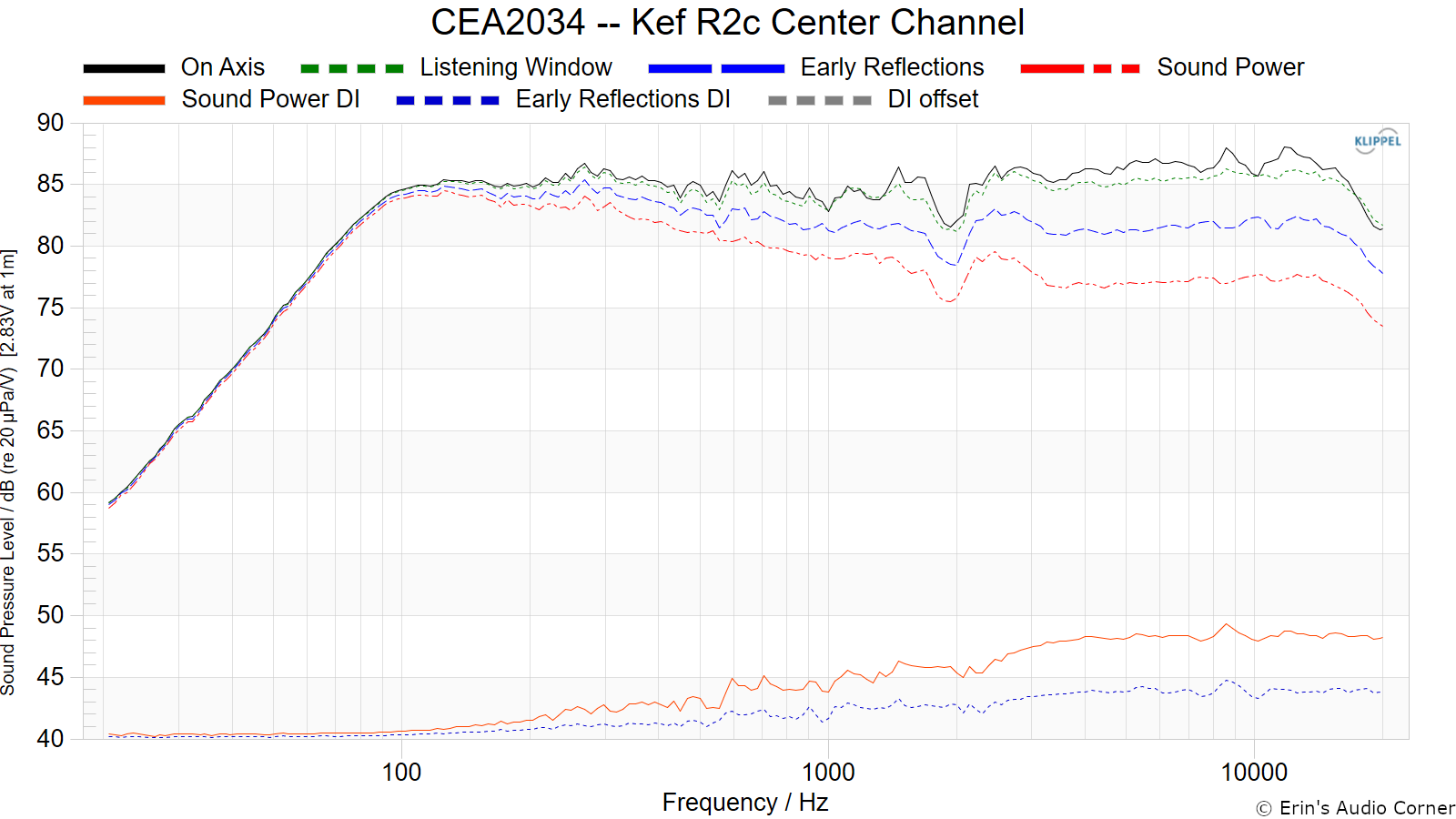
Early Reflections Breakout:
Floor bounce: average of 20º, 30º, 40º down
Ceiling bounce: average of 40º, 50º, 60º up
Front wall bounce: average of 0º, ± 10º, ± 20º, ± 30º horizontal
Side wall bounces: average of ± 40º, ± 50º, ± 60º, ± 70º, ± 80º horizontal
Rear wall bounces: average of 180º, ± 90º horizontal
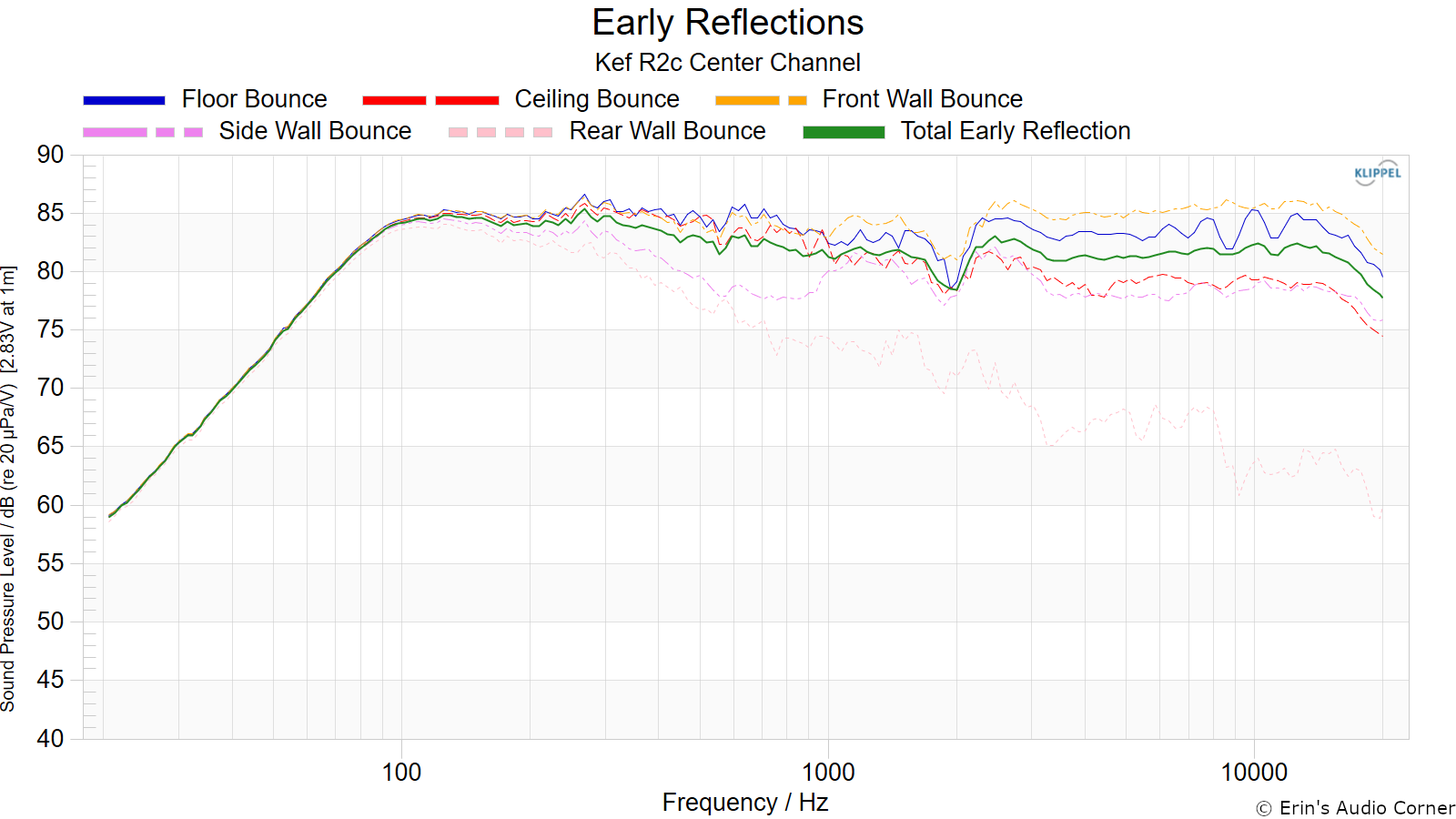
Estimated In-Room Response:
In theory, with complete 360-degree anechoic data on a loudspeaker and sufficient acoustical and geometrical data on the listening room and its layout it would be possible to estimate with good precision what would be measured by an omnidirectional microphone located in the listening area of that room. By making some simplifying assumptions about the listening space, the data set described above permits a usefully accurate preview of how a given loudspeaker might perform in a typical domestic listening room. Obviously, there are no guarantees, because individual rooms can be acoustically aberrant. Sometimes rooms are excessively reflective (“live”) as happens in certain hot, humid climates, with certain styles of interior décor and in under-furnished rooms. Sometimes rooms are excessively “dead” as in other styles of décor and in some custom home theaters where acoustical treatment has been used excessively. This form of post processing is offered only as an estimate of what might happen in a domestic living space with carpet on the floor and a “normal” amount of seating, drapes and cabinetry.
For these limited circumstances it has been found that a usefully accurate Predicted In-Room (PIR) amplitude response, also known as a “room curve” is obtained by a weighted average consisting of 12 % listening window, 44 % early reflections and 44 % sound power. At very high frequencies errors can creep in because of excessive absorption, microphone directivity, and room geometry. These discrepancies are not considered to be of great importance.

Horizontal Frequency Response (0° to ±90°):

Vertical Frequency Response (0° to ±40°):
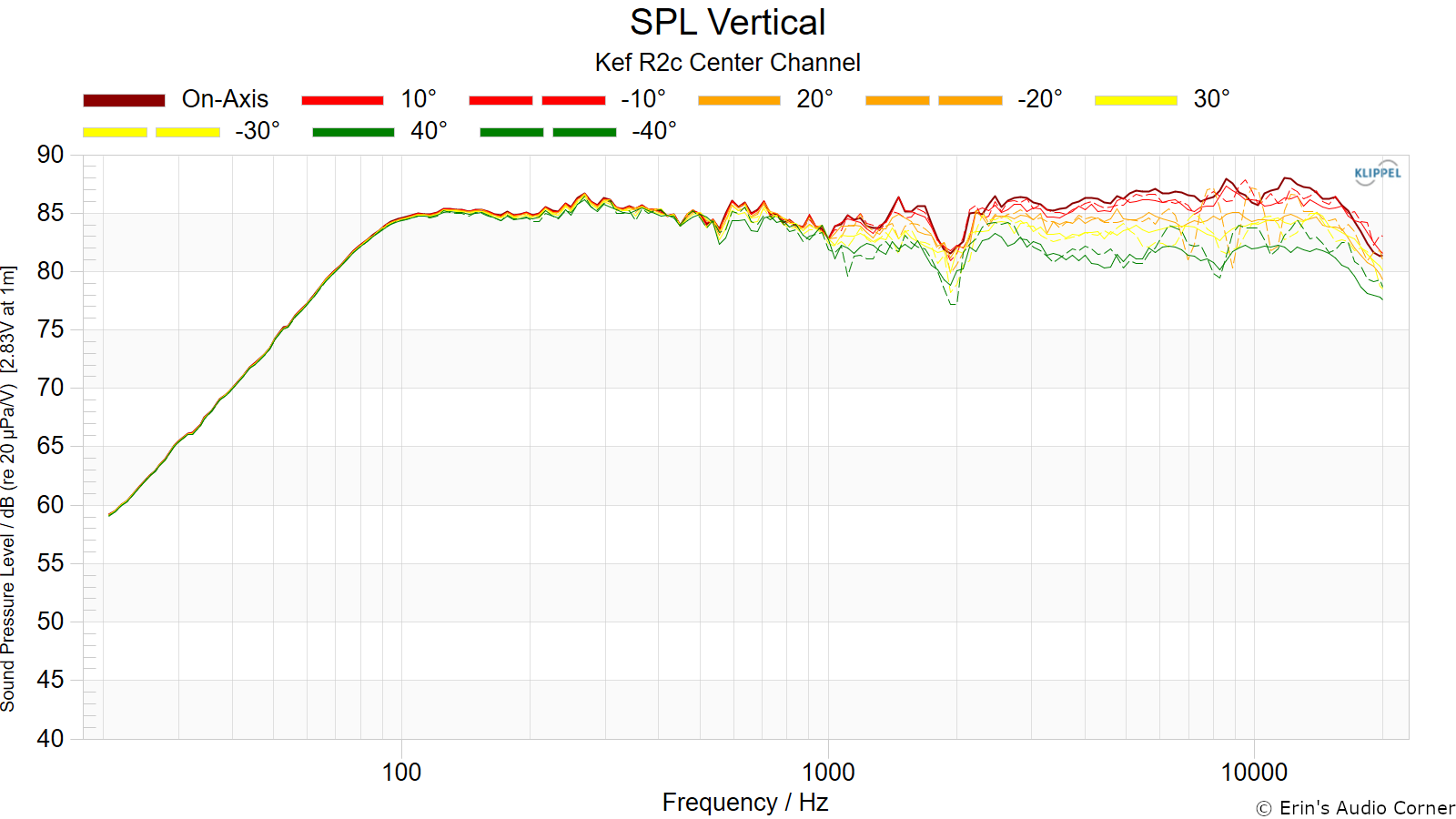
Horizontal Contour Plot (not normalized):
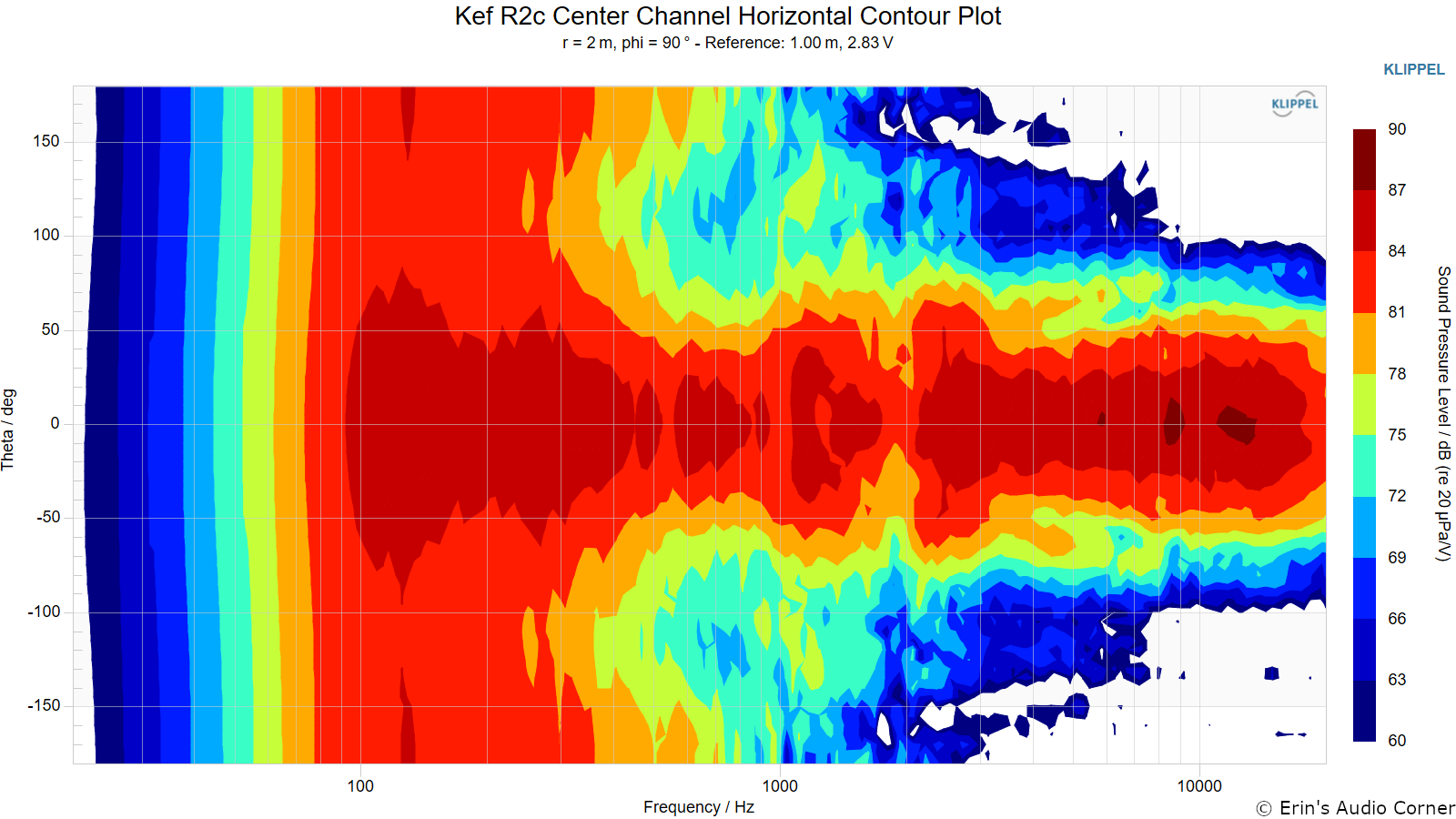
Vertical Contour Plot (not normalized):
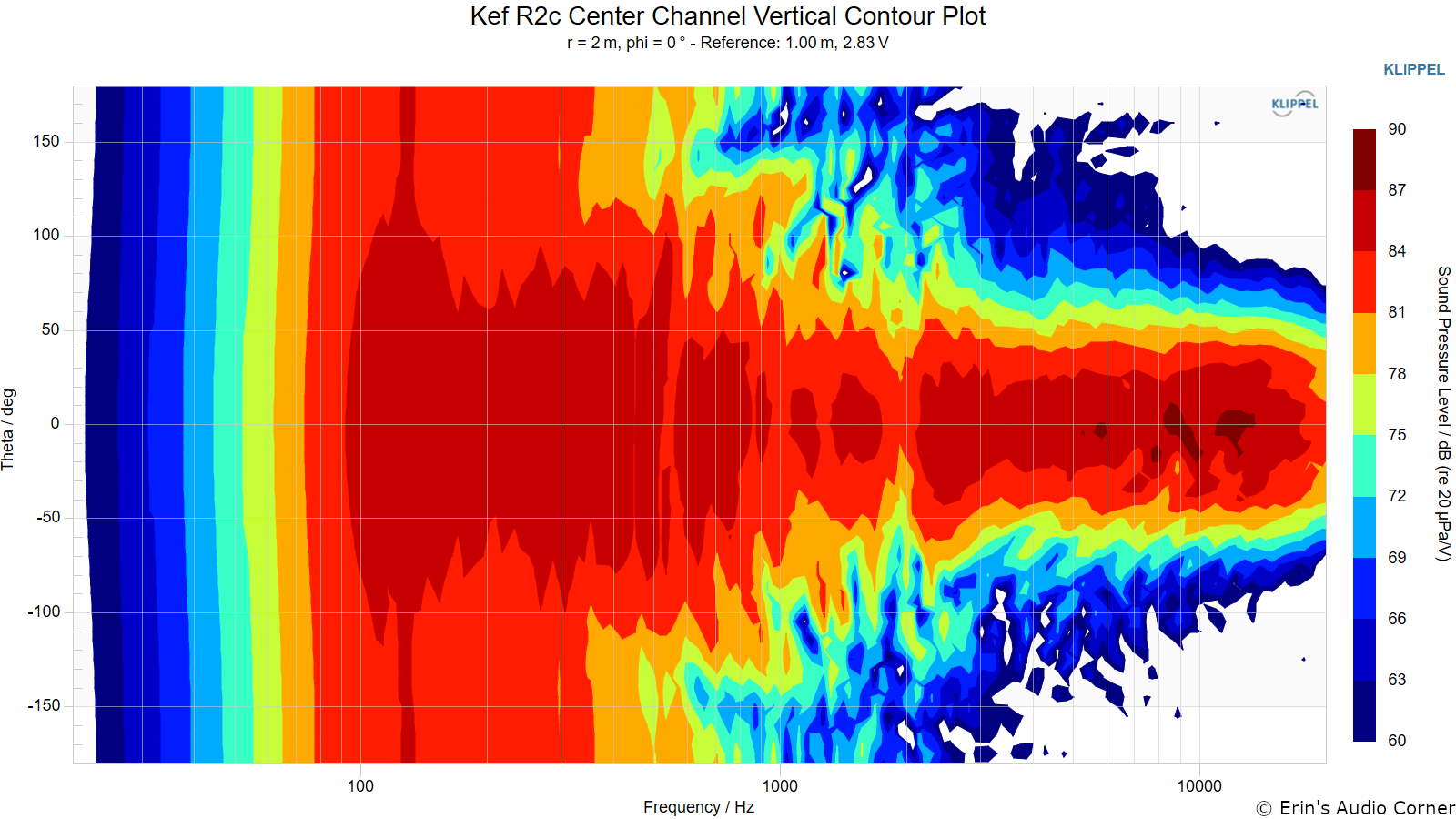
“Globe” Plots
Horizontal Polar (Globe) Plot:
This represents the sound field at 2 meters - above 200Hz - per the legend in the upper left.
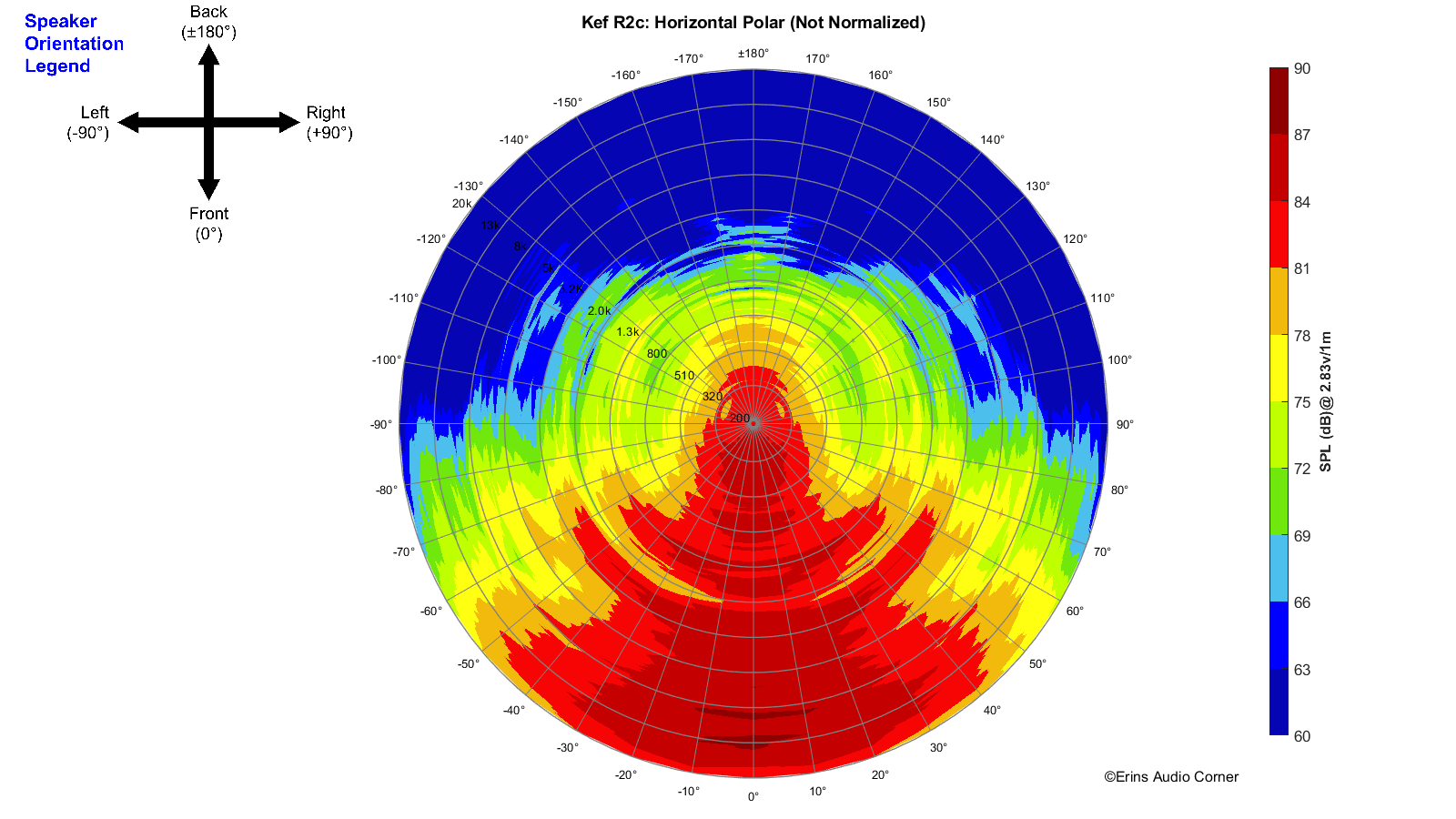
Vertical Polar (Globe) Plot:
This represents the sound field at 2 meters - above 200Hz - per the legend in the upper left.
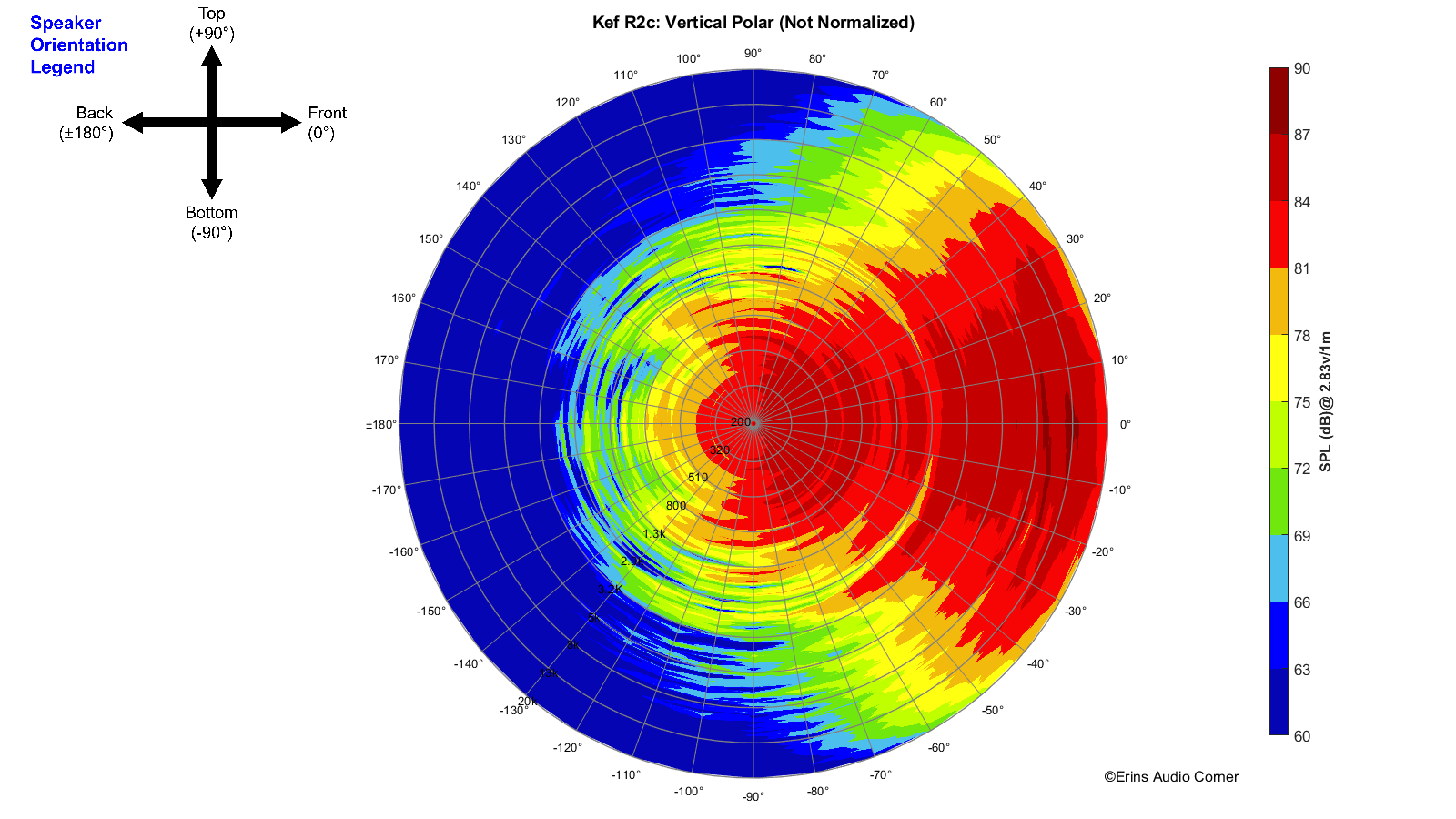
Additional Measurements
On-Axis Response Linearity
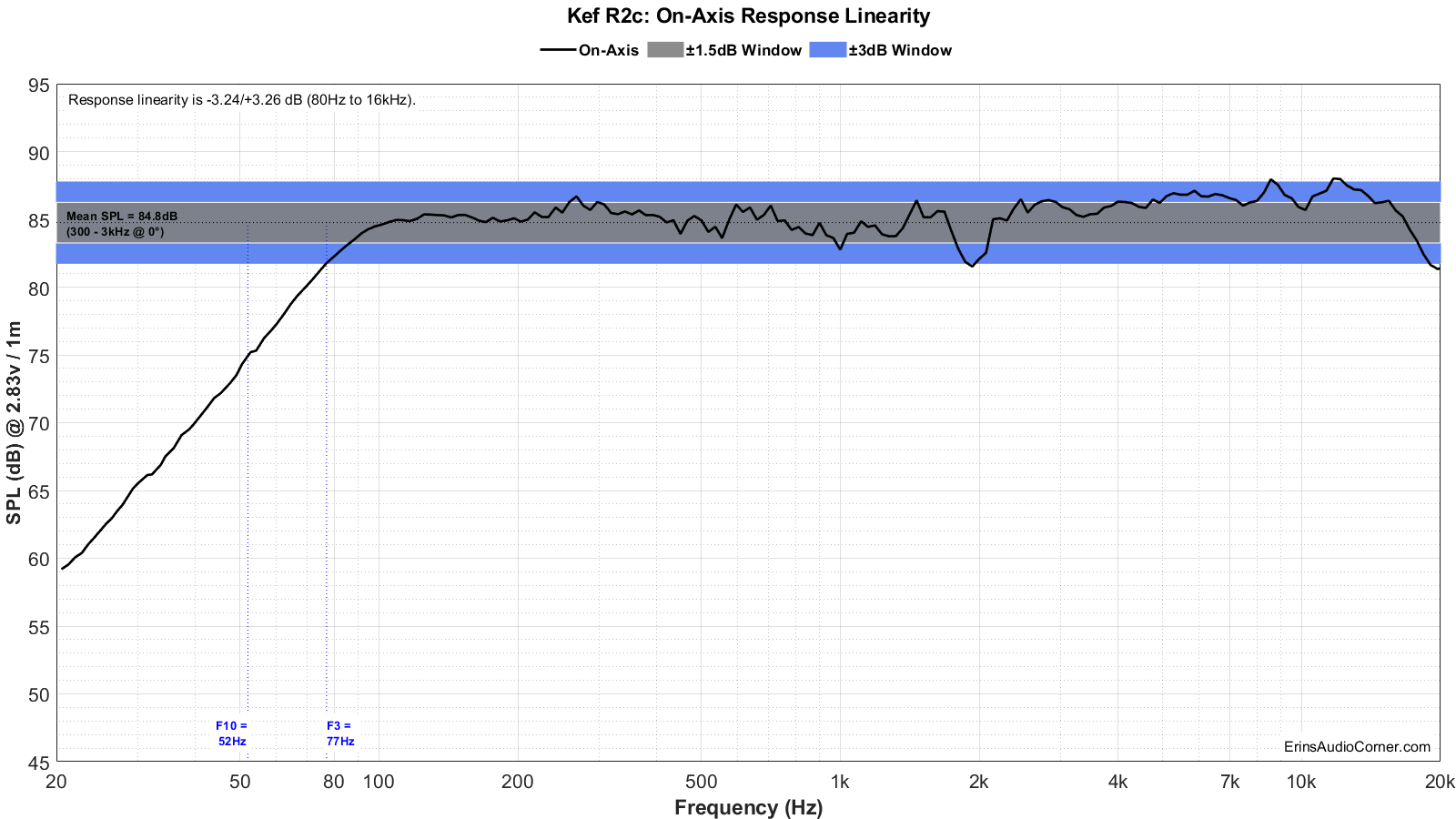
Impedance Magnitude and Phase + Equivalent Peak Dissipation Resistance (EPDR)
For those who do not know what EPDR is (ahem, myself until 2020), Keith Howard came up with this metric which he defined in a 2007 article for Stereophile as:
… simply the resistive load that would give rise to the same peak device dissipation as the speaker itself.
A note from Dr. Jack Oclee-Brown of Kef (who supplied the formula for calculating EPDR):
Just a note of caution that the EPDR derivation is based on a class-B output stage so it’s valid for typical class-AB amps but certainly not for class-A and probably has only marginal relevance for class-D amps (would love to hear from a class-D expert on this topic).
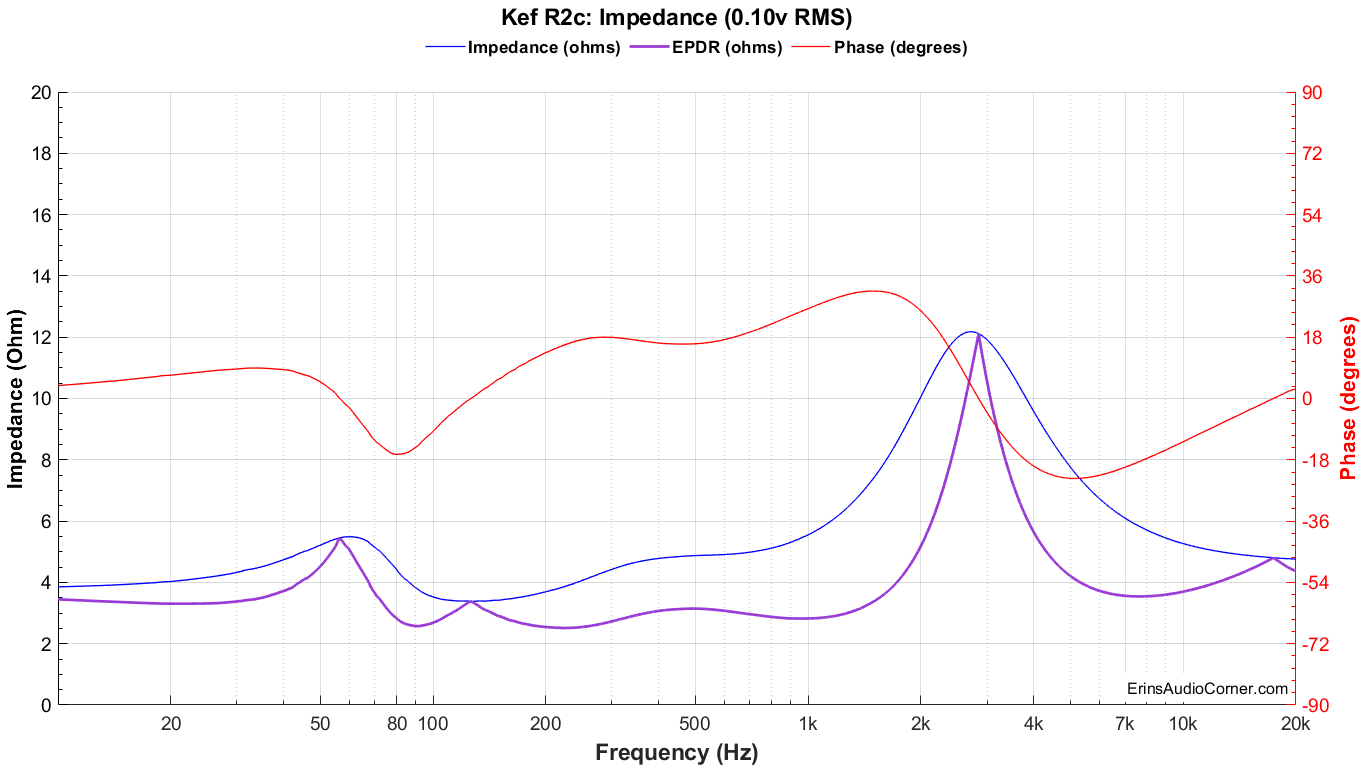
I was curious what would happen if you increased the voltage to 2.83vRMS so I measured the impedance at this voltage level and plotted the EPDR for it and 0.10vRMS below. The two are identical and therefore you see only what appears to be one set of data in the graph below. This is a good thing as it shows the drivers are operating in their linear range even in the 2.83v testing.
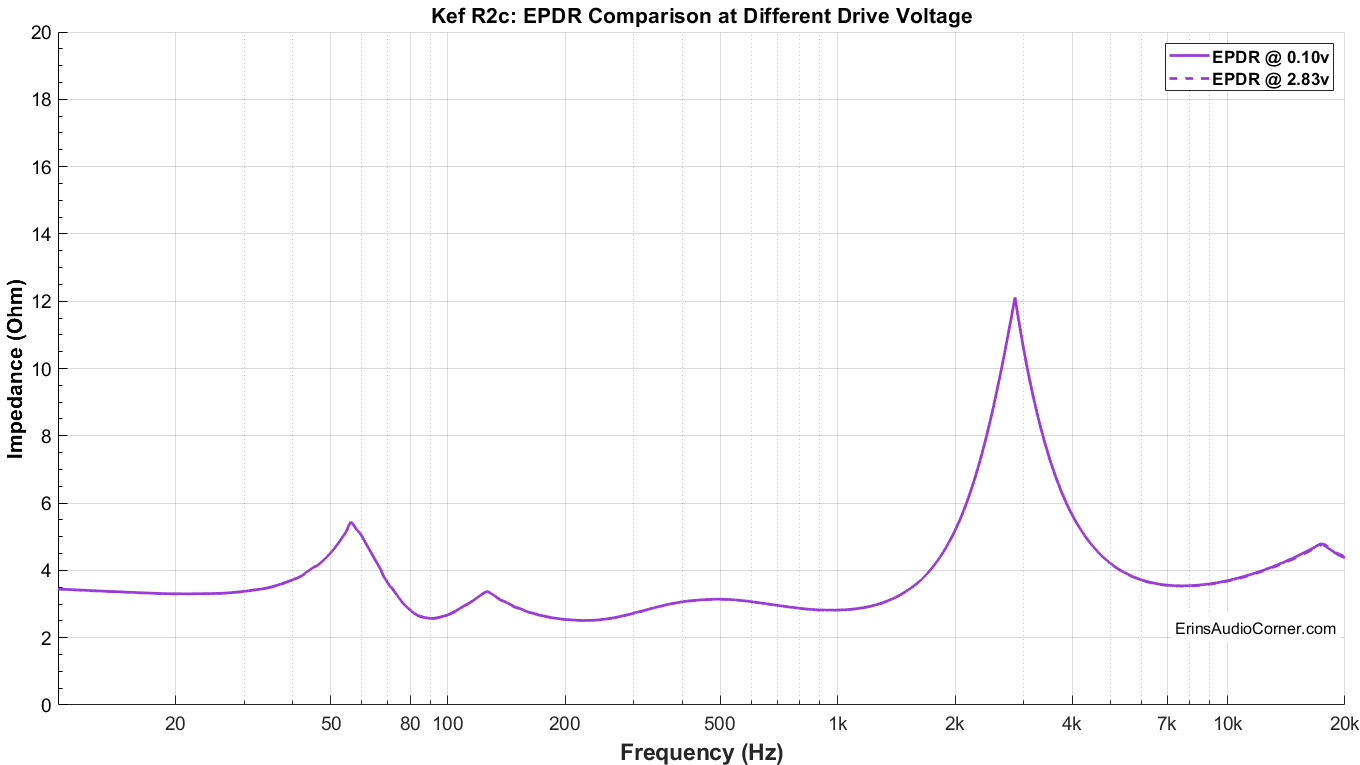
Step Response
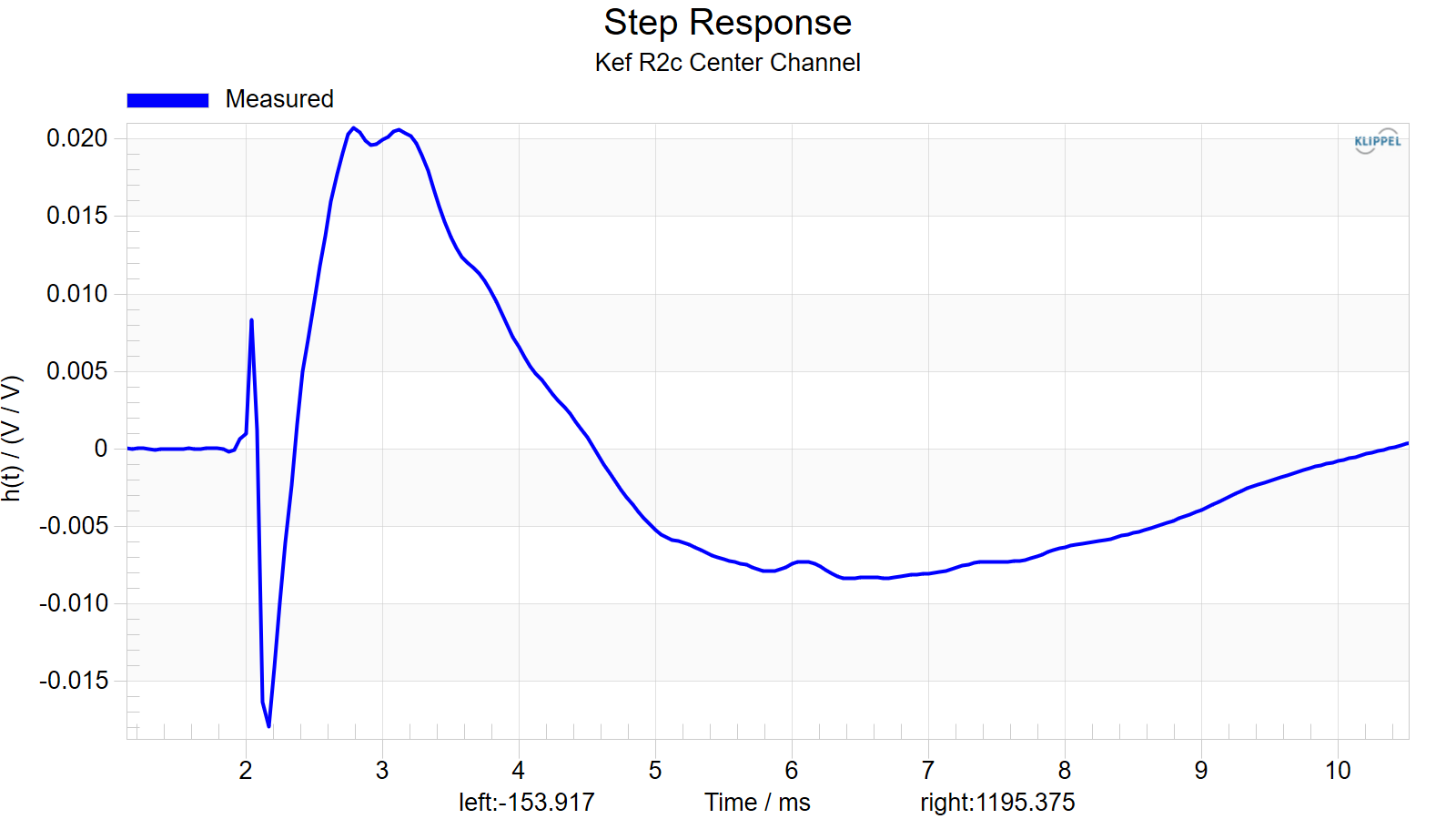
Near-Field Response
Nearfield response of individual drive units:
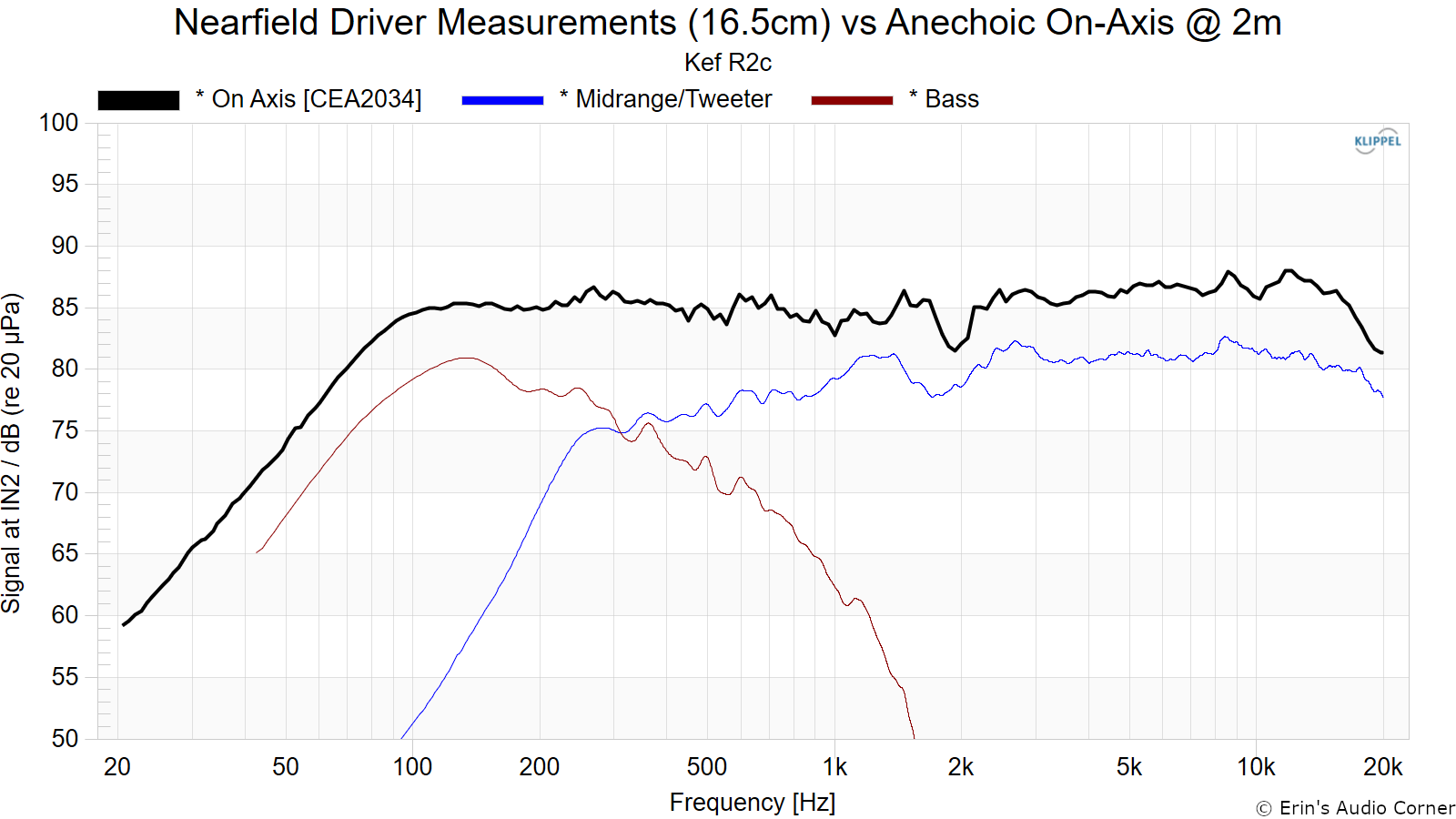
Harmonic Distortion
Harmonic Distortion at 86dB @ 1m:
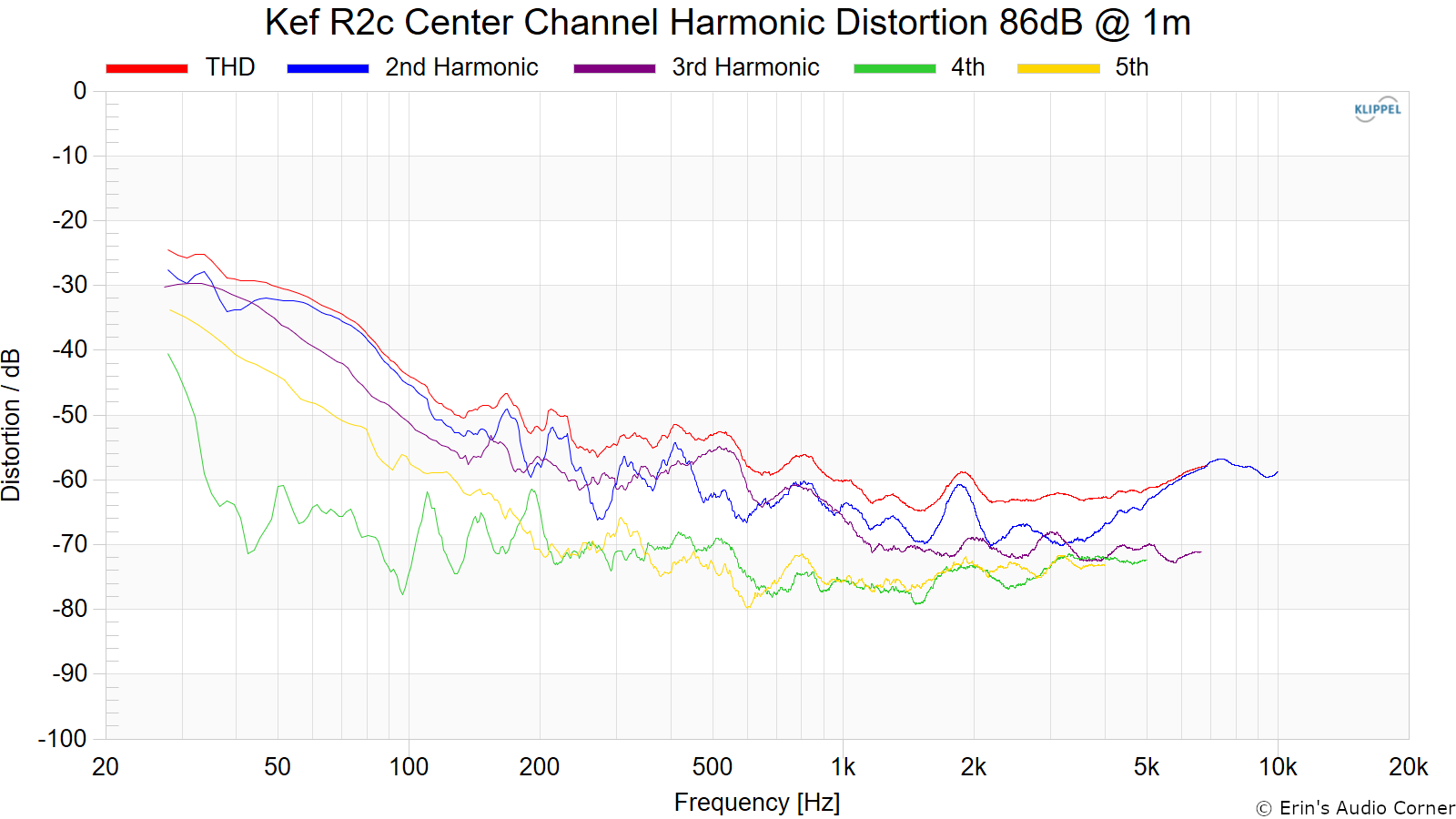
Harmonic Distortion at 96dB @ 1m:
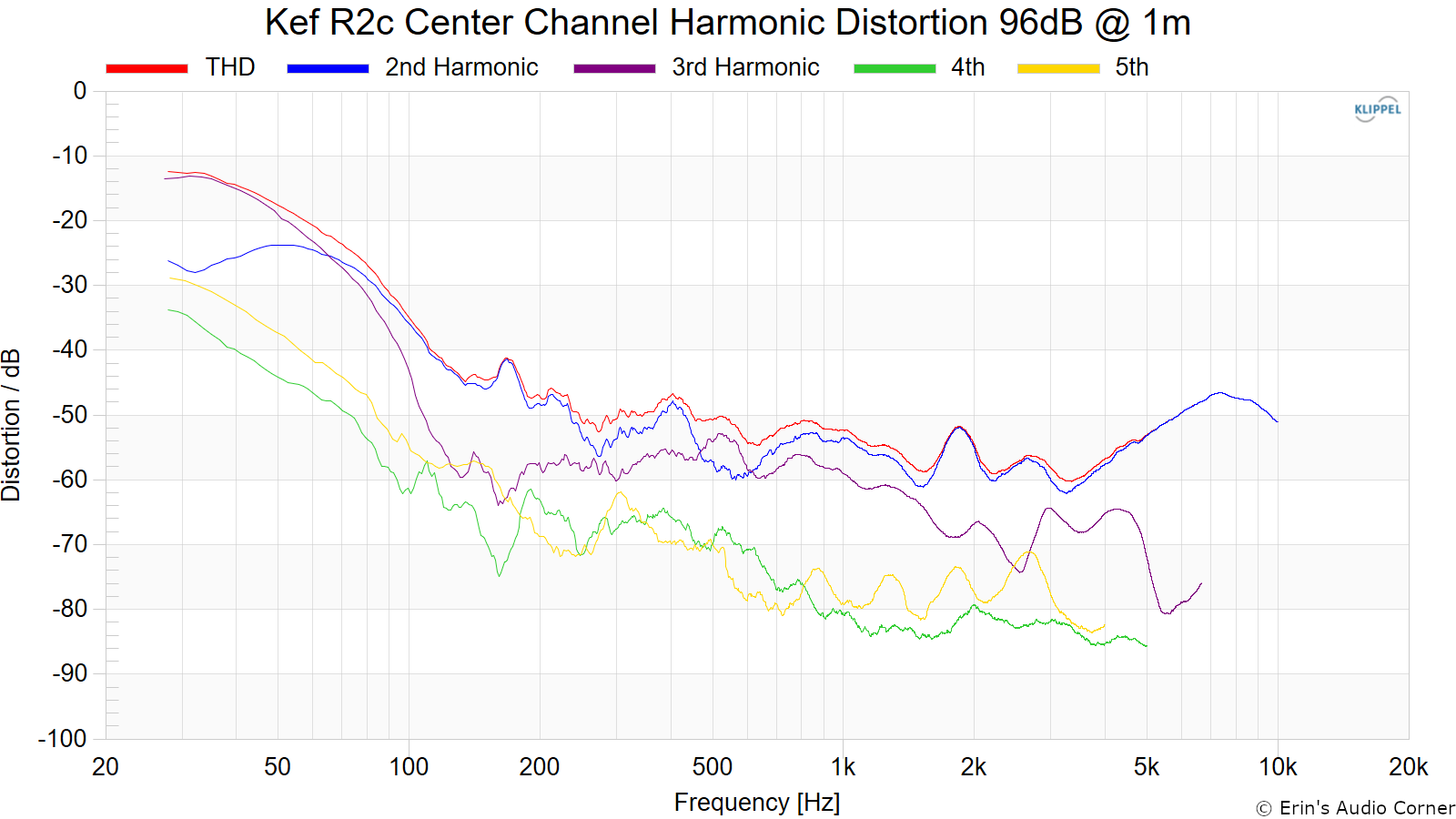
Dynamic Range (Instantaneous Compression Test)
The below graphic indicates just how much SPL is lost (compression) or gained (enhancement; usually due to distortion) when the speaker is played at higher output volumes instantly via a 2.7 second logarithmic sine sweep referenced to 76dB at 1 meter. The signals are played consecutively without any additional stimulus applied. Then normalized against the 76dB result.
The tests are conducted in this fashion:
- 76dB at 1 meter (baseline; black)
- 86dB at 1 meter (red)
- 96dB at 1 meter (blue)
- 102dB at 1 meter (purple)
The purpose of this test is to illustrate how much (if at all) the output changes as a speaker’s components temperature increases (i.e., voice coils, crossover components) instantaneously.

Long Term Compression Tests
The below graphics indicate how much SPL is lost or gained in the long-term as a speaker plays at the same output level for 2 minutes, in intervals. Each graphic represents a different SPL: 86dB and 96dB both at 1 meter.
The purpose of this test is to illustrate how much (if at all) the output changes as a speaker’s components temperature increases (i.e., voice coils, crossover components).
The tests are conducted in this fashion:
- “Cold” logarithmic sine sweep (no stimulus applied beforehand)
- Multitone stimulus played at desired SPL/distance for 2 minutes; intended to represent music signal
- Interim logarithmic sine sweep (no stimulus applied beforehand) (Red in graphic)
- Multitone stimulus played at desired SPL/distance for 2 minutes; intended to represent music signal
- Final logarithmic sine sweep (no stimulus applied beforehand) (Blue in graphic)
The red and blue lines represent changes in the output compared to the initial “cold” test.

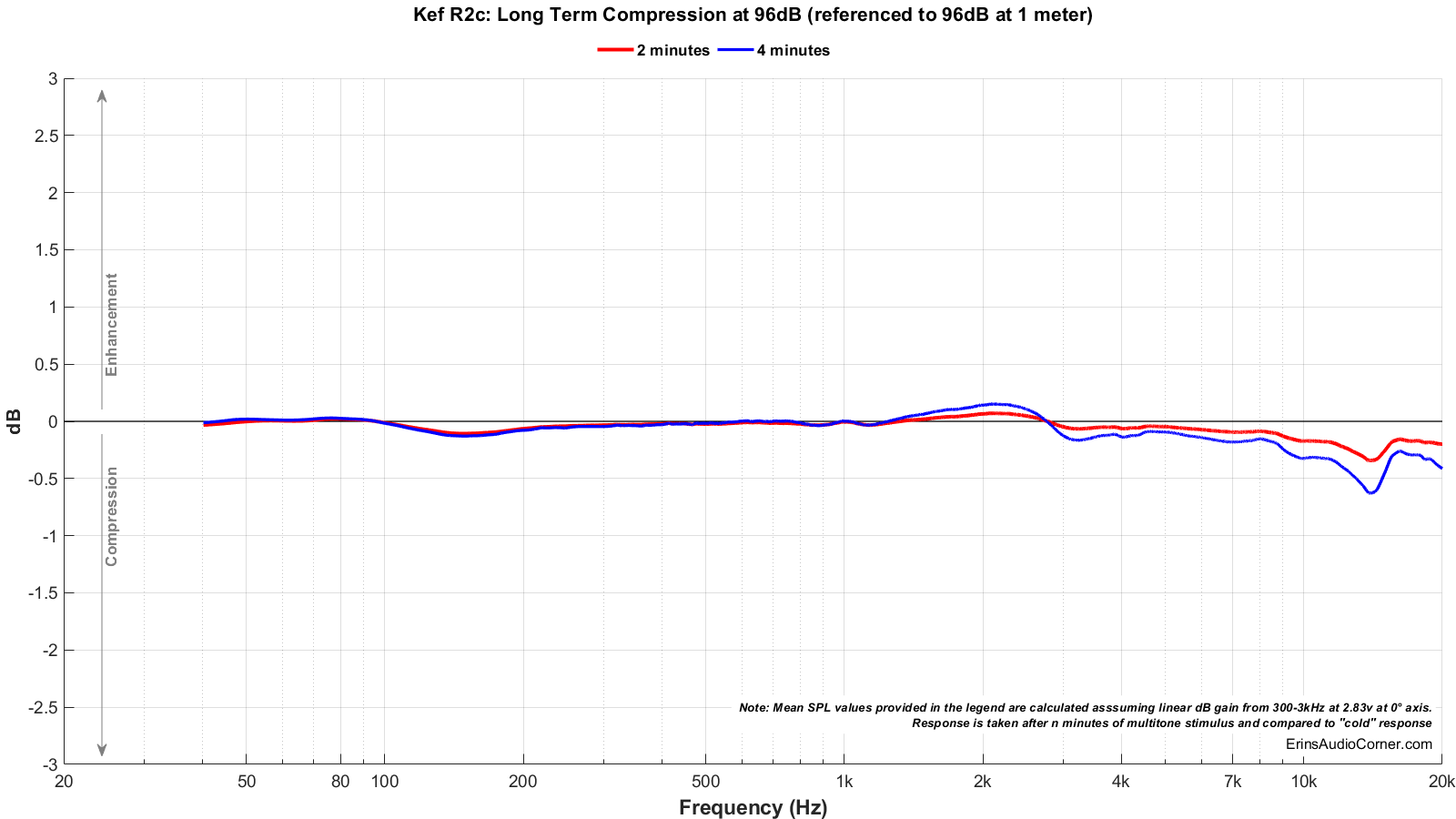
Cumulative Spectral Decay (CSD)

Grille Effect
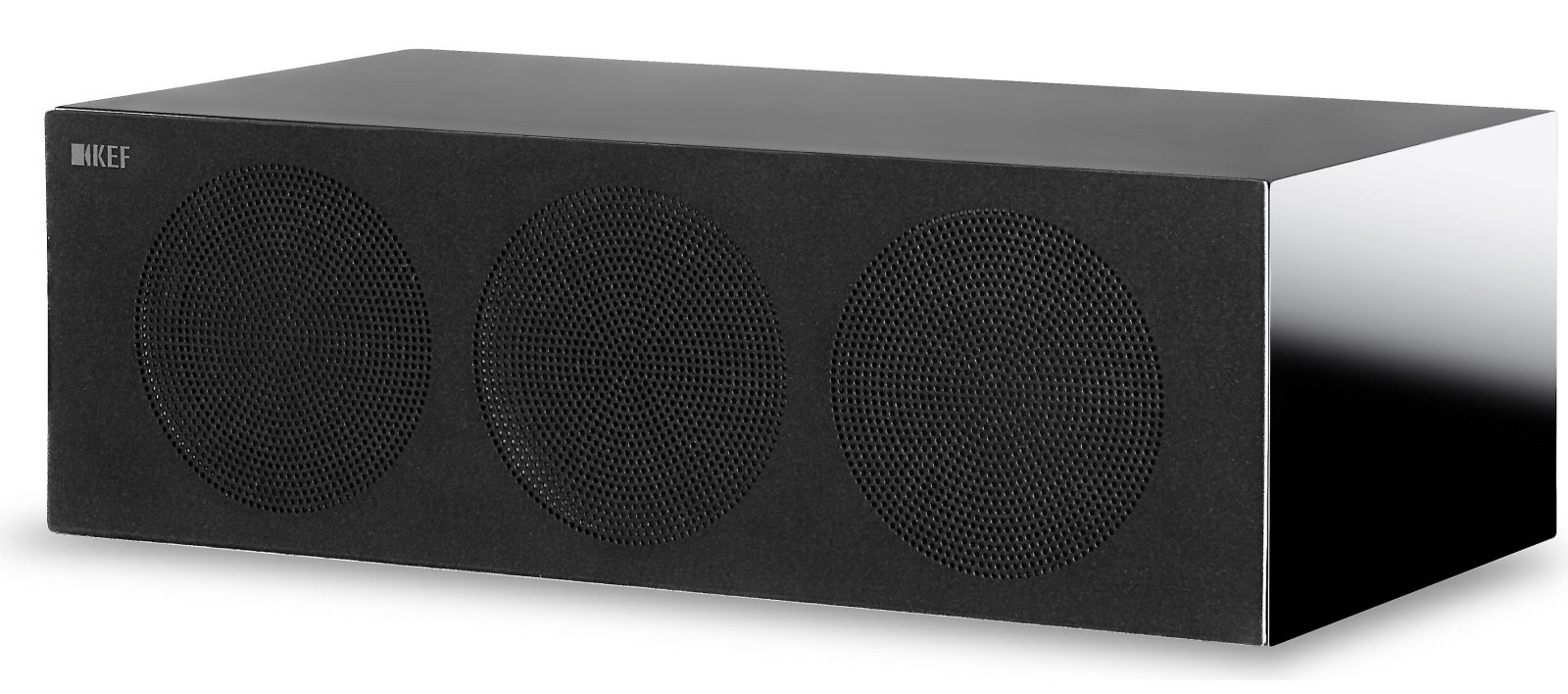
What happens when you put the grille on? Comb filtering. How bad? Well, see for yourself:
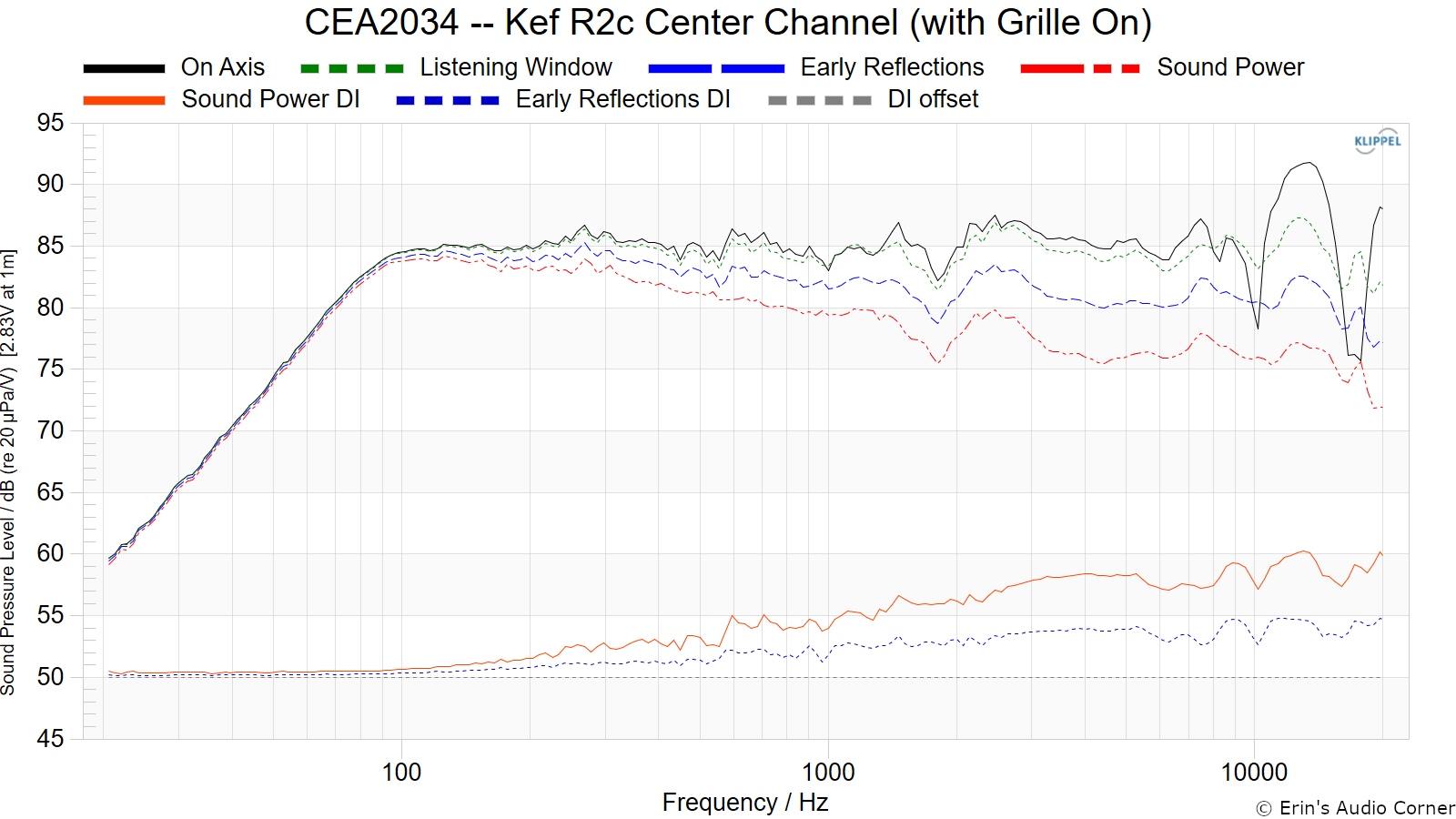

Vertical Orientation SPIN Results
Same as previously seen, this time with the speaker standing upright.

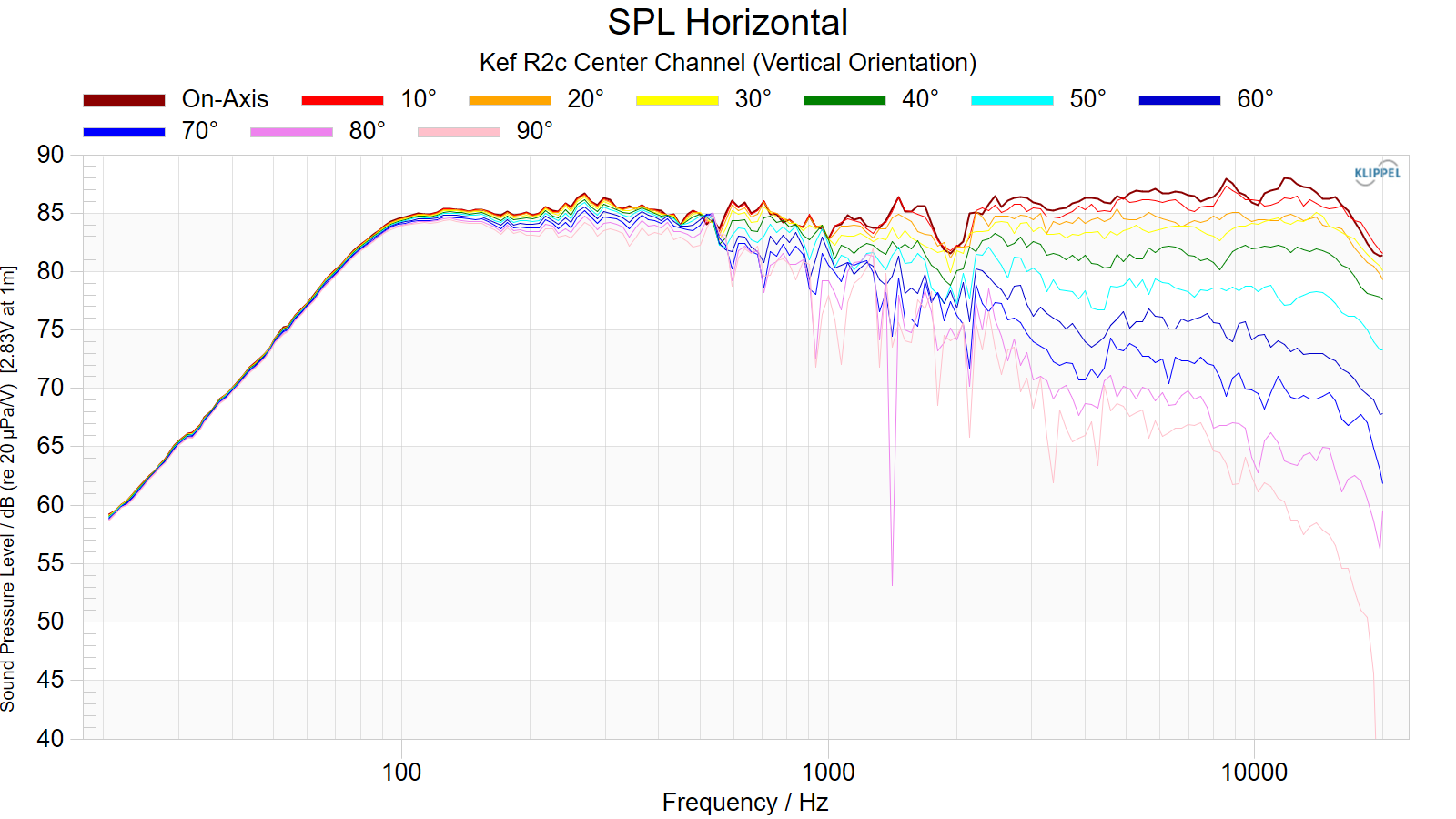
Not much change here but that is expected given the concentric design. However, there is still some difference in the early reflection directivity index. While minor, it may be useful to compare this orientation of the R2c to that of the Kef R3 I tested a few months ago in case you are considering purchasing this speaker for L/C/R purposes in a home theater as I know some have expressed interest in this very thing. (Side note: if you want to flush mount them in a wall, make sure you have DSP handy to counter the baffle step built into the passive network here).
Parting / Random Thoughts
If you want to see the music I use for evaluating speakers subjectively, see my Spotify playlist.
I encourage you to watch my YouTube review for more details but a quick few notes:
- Subjective listening was mainly in the farfield at 3-4 meters in an open floorplan living room. Subjective listening was conducted at 80-95dB at these distances and occasionally higher. Higher volumes were done simply to test the output capability in case one wants to try to sit further away. Listening was mostly on-axis with the occasional off-axis listening to see how the dispersion pattern checked out for listeners who would be sitting to the side in home theater situations.
- I used both a Parasound NewClassic 200 Integrated as well as their HINT 6 integrated for my tests. I found quickly that I the 110w on the 200 wasn’t sufficient to really “go big” on this speaker, given the mild sensitivity of . The additional power of the H-INT6 was needed to provide adequate volume for my listening tests.
- At approximately 4m listening distance, I found the max SPL to be about 95dB. This is a respectable number but let me note that this was also full-range. And in listening full range to more bass heavy music (rap), the lights in my room actually dimmed when a bass note would hit. This tells me two things: 1) If you plan to use this full-range then you’re going to need a beefy amplifier. I was using a Parasound HINT6 and it drove the amplifier without issue but the simple fact that the impedance in the 80-200Hz region is below 4 Ohms indicates you’re going to need some reserve power. 2) Ignore number 1 because you should not be using this speaker full-range and I would suggest a crossover no lower than the typical 80Hz if you plan to really get on these speakers. Let your subwoofer(s) handle the lower frequency stuff and take the stress off of your speakers.
- There was a strong “chk” sound in these speakers with many of the female vocals I listened to and when looking at the data, I suspect this is a problem of the 2.5kHz region.
- While the overall tonality of these speakers is mostly neutral through the midrange, there is a subtle high frequency increase above about 2kHz. Some may prefer this while others may not.
- By far the most ear-catching thing about this speaker (for the bad, unfortunately) was the high degree of sibilance. This was unmistakable in my listening. I used a 1/3-octave graphic EQ to narrow down the offending frequency range and it seemed to occur in the 8kHz region; cutting about 2.5dB helped this a lot. When looking at the data the on-axis response shows a peaking around 8.5kHz and I’m left to only conclude this is the issue I was hearing. Either that, or it’s a combination of this and the high frequency bump. If I am being honest, this would be cause for me to not to purchase these speakers if I didn’t have EQ. Luckily, nearly every home theater incorporates equalization and this is rather easy to fix.
- As with the Kef R3, the depth of the soundstage in the R2c is superb and extends well past the physical speaker’s placement (at least, when placed off a wall).
- Also, I wrote the following about the Kef R3 and the results here are no different so I’ll just copy/paste the same thing: The layering of these speakers is unmatched, to date. The soundstage isn’t terribly wide (I prefer a wider soundstage). However, the layering and the overall depth of the soundstage is incredible. The soundstage extends deep from front to back (with the right source music, of course). It is one of my favorite things about these speakers. A good example of this is in Fleetwood Mac’s “The Chain” as well as Phillip Bailey’s “Easy Lover” (at the 3:00 mark, where Phil Collins gets down on the drums).
- Step response shows a couple anomalies at approximately 1ms and 4ms (relative to IR peak). These equate to 1kHz and 250Hz, respectively. And when you look in the data you can see some signs of perturbations there. The 1kHz doesn’t strike me as obvious; you really have to start putting things together before this stands out. However, the 250Hz area shows a lingering resonance that syncs up well with the CSD graphic as well as the SPIN data. Do I know this is a problem? No, not really. Do I find it interesting and more than just coincidence (no pun intended)? Yes, I do. Given the relative level of the “resonances” here, as seen in the “stacking” of the horizontal response as well as the SPIN data in this region, BUT the magnitude being rather low, I can’t say it is something I would expect most to notice; let alone find offensive. Additionally, there is no hint of this in the impedance sweep which indicates that rather than being a resonance, it is more likely a diffraction effect. Again, this is me doing some armchair engineering. I think it’s worthwhile to point out, though, in the interest of learning and learning how to question the data and how that relates to what we hear.
- Looking at the horizontal response it is pretty obvious that there is a directivity mismatch between the dual woofers and the midrange. Why is that, though? Shallow(er) crossover slopes. This is evidenced in the nearfield response. However, it seems to “come out in the wash” with the early reflections and estimated in-room response showing little influence from this. Though, I can’t help but wonder if steeper slopes would help, sonically.
- Make sure to push the trim rings all the way in.
- Again, this speaker absolutely needs a subwoofer.
As stated in the Foreword, this written review is purposely a cliff’s notes version. For more details about the performance (objectively and subjectively) please watch the YouTube video.
Support the Cause
If you like what you see here and want to help support the cause there are a few ways you can do so:
- Join my Patreon here.
- Contribute via PayPal here.
- Using my Amazon affiliate link below as it helps me gain a small commission at no additional cost to you.
Your support helps me pay for new items to test, hardware, miscellaneous items and costs of the site’s server space and bandwidth. All of which I otherwise pay out of pocket. So, if you can help chip in a few bucks, know that it is very much appreciated.
You can also join my Facebook and YouTube pages if you’d like to follow along with updates.